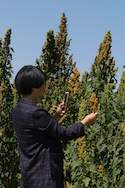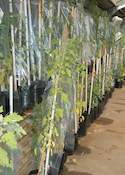
Quinoa (Chenopdium quinoa Willd.) is traditionally grown on arid and desolate high plains of the Andes Mountains in South America where its growth takes place in intense sunlight and often frigid conditions in winter.
There are thousands of types, stemming from approximately 300 wild-growing bio-types available in Andean production areas. The options for finding candidates suitable for sustainable consistent production, required for commercial establishment in hot and dry parts of South Africa, may however be limited.
William Weeks, an experienced agricultural scientist at the North-West Department of Agriculture and Rural Development who is working extensively on quinoa development in South Africa, explains more about growing quinoa:
Quinoa is a cool-weather drought-tolerant crop with peculiar traits. It can survive in temperatures as low as -8°C (prior to flowering) and tolerate temperatures as high as 38°C but will not pollinate at temperatures above 30ºC.
Quinoa grows from sea level to elevations as high as 4 000m in its native countries and can tolerate a wide variety of soil types and survive in a pH range from 4,5 to 8,5. Survival, however, does not mean the crop will yield commercially optimal yields. Optimal soil temperature for germination averages around 14°C.
Quinoa seed coats are highly water permeable and the seed can rapidly absorb and/or lose moisture. As a result, any rain during seed ripening will result in rapid germination while seeds are still unharvested, resulting in crop loss. This peculiar trait associated with Chenopodium seed also shortens shelf-life under storage conditions.
Quinoa plants are day-length sensitive. This means that the sowing date may influence plant development throughout different growth stages, depending on the latitude from which any particular quinoa type originated in relation to the latitude where it is grown.
South African researcher, William Weeks, visited China as part of a research exchange delegation to the Gansu province.
Research on Quinoa

Above-mentioned factors indicate what South African quinoa research is focusing on; overcoming the limitations of growing this cool-weather crop by searching for quinoa types that can produce consistent yields under local climatic conditions. Evaluating alternative species better adapted to higher temperatures is an approach that could enable future large scale quinoa production in South Africa.
According to Mr Weeks, evaluation of types originating from more tropical climatic zones within countries such as Bolivia is also being considered as a further option.
Current efforts on quinoa research in South Africa is linked through inter-institutional and inter-disciplinary networking within the NuGrain Consortium which hosts bi-annual meetings.
Institutions included in new crop research include Free State University, UNISA, North-West Department of Agriculture and Rural Development (DARD), the Agricultural Research Council and the private sector. Research links are also being established with China and Lesotho.
There is a future for quinoa production in South Africa, be it in an adapted form or via the development of related crop types. Equivalent alternatives such as grain amaranth, which are able to flourish under local climatic conditions are also being actively pursued.
Compared to amaranth, quinoa is generally less adapted to local conditions and new quinoa farmers are advised to first test the crop on a smaller scale before planting commercial-size plots.
At the propagation facility at the Departement of Rural Development in Potchefstroom, quinoa plants are kept at temperatures around 15°C. High temperatures may lead to a loss in viability.
Quinoa Pests and Diseases
Pests most likely to affect quinoa are aphids, a recently confirmed stem boring weevil and beet armyworm. Viruses infecting spinach and beetroot have also been seen in quinoa.
Damage to maturing seed caused by larger predators such as birds and mammals is generally limited by the saponin on quinoa seeds. Saponin is a bitter-tasting compound that is removed (by washing the seeds) before packaging it as human food. Saponin content varies and low saponin varieties are being developed internationally.
Weeds are more difficult to control in slow-growing quinoa as it struggles with competition. As yet (2019) no herbicides for quinoa are registered in South Africa.
By Marinda Louw